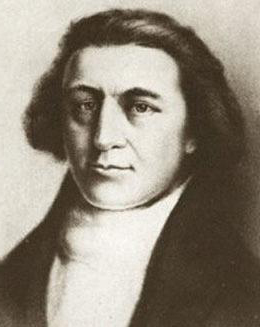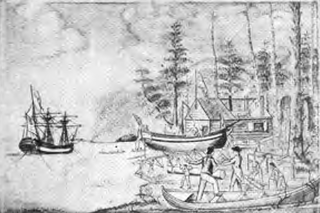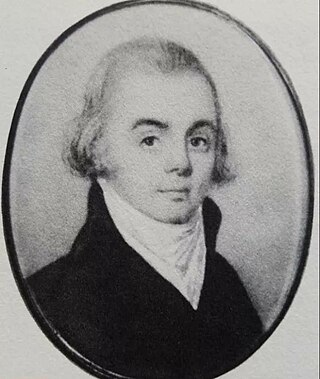
Robert Gray was an American merchant sea captain who is known for his achievements in connection with two trading voyages to the northern Pacific coast of North America, between 1790 and 1793, which pioneered the American maritime fur trade in that region. In the course of those voyages, Gray explored portions of that coast and in the year 1790 he completed the first American circumnavigation of the world. He was also noted for coming upon and naming the Columbia River, in 1792, while on his second voyage.
John Kendrick (1740–1794) was an American sea captain during the American Revolutionary War, and was involved in the exploration and maritime fur trading of the Pacific Northwest alongside his subordinate Robert Gray. He was the leader of the first US expedition to the Pacific Northwest. He is known for his role in the 1789 Nootka Crisis, having been present at Nootka Sound when the Spanish naval officer José Esteban Martínez seized several British ships belonging to a commercial enterprise owned by a partnership of companies under John Meares and Richard Cadman Etches. This incident nearly led to war between Britain and Spain and became the subject of lengthy investigations and diplomatic inquiries.

Columbia Rediviva was a privately owned American ship under the command, first, of John Kendrick, and later Captain Robert Gray, best known for being the first American vessel to circumnavigate the globe, and her expedition to the Pacific Northwest for the maritime fur trade. "Rediviva" was added to her name upon a rebuilding in 1787. Since Columbia was privately owned, she did not carry the prefix designation "USS".

In May 1792, American merchant sea captain Robert Gray sailed into the Columbia River, becoming the first recorded American to navigate into it. The voyage, conducted on the privately owned Columbia Rediviva, was eventually used as a basis for the United States' claim on the Pacific Northwest, although its relevance to the claim was disputed by the British. As a result of the outcome the river was afterwards named after the ship. Gray spent nine days on the river trading fur pelts before sailing out of the river.

Adventure was built by the crew of Captain Robert Gray on his second voyage in the maritime fur trade to the Northwest Coast of North America. The 45-ton sloop was built to allow the trading venture to access smaller inlets the Columbia could not reach. At the end of his second voyage Gray sold the ship to the Spanish Navy. It was renamed Orcacitas and served the Naval Department of San Blas for some years.

Fort Defiance was a small outpost that the crew of the Columbia Rediviva built as winter quarters during 1791–1792 on Meares Island in present-day British Columbia, Canada. American merchant and maritime fur trader Captain Robert Gray was in command.

Joseph Ingraham (1762–1800) was an American sailor and maritime fur trader who discovered several islands of the Marquesas Islands while on his way to trade along the west coast of North America. He was also a prisoner in the American Revolutionary War and an officer in the United States Navy.

Robert Haswell was an early American maritime fur trader to the Pacific Northwest of North America. His journals of these voyages are the main records of Captain Robert Gray's circumnavigation of the globe. Later during the Quasi-War he served as an officer in the United States Navy.
Koyah, also Xo'ya, Coya, Coyour, Kower, Kouyer (Haida: Xhuuyaa - "Raven", was the chief of Ninstints or Skungwai, the main village of the Kunghit-Haida during the era of the Maritime Fur Trade in Haida Gwaii off the North Coast of British Columbia, Canada. Koyah was involved in more conflicts with ship captains than any other chief of his period and figures prominently in histories of the fur trade and coastal exploration.
Simon Metcalfe was a British-born American surveyor and one of the first American maritime fur traders to visit the Pacific Northwest coast.

Duff was a ship launched on the Thames in 1794. In 1796 the London Missionary Society engaged her to take a party of missionaries to the South Pacific. Once she had landed the missionaries she sailed to China and took a cargo back to England for the British East India Company. On this voyage her captain named a variety of South Pacific islands. On her second voyage to deliver missionaries a French privateer captured her in 1799 off the coast of Brazil on the outward-bound leg of her voyage.
Thomas Humphrey Metcalfe was an American maritime fur trader who worked with his father, Simon Metcalfe. After being separated from his father in a storm, Thomas sailed a small schooner with a crew of four from the vicinity of China to Nootka Sound on Vancouver Island where he was arrested by the Spanish. After being released he sailed to Hawaii, hoping to find his father. Instead, he was attacked and killed by Native Hawaiians in revenge for misdeeds committed by his father just days before.
Jenny was built at Newfoundland in 1783. She sailed to Britain and traded between Britain and Newfoundland and then between Bristol and Africa until 1790 when Sydenham Teast purchased her. Between 1791 and 1794 she made two voyages exploring the Pacific Northwest and gathering sea otter pelts. In 1796 she returned to trading with Africa but was lost in January 1797 as she was returning to Bristol from Africa.
Union was an American sloop built in Somerset, Massachusetts in 1792. It is best known for its circumnavigation of the world, 1794–1796, under the maritime fur trader John Boit.

John Boit Jr. was one of the first Americans involved in the maritime fur trade. He sailed as fifth mate under Captain Robert Gray on the second voyage of the Columbia Rediviva, 1790–1793. During the voyage he wrote a short but important journal in which he described the first time the Columbia River was located by Europeans or European Americans.
Hope was an American brigantine built at Kittery, Maine in 1789 for use in the maritime fur trade and owned by Thomas Handasyd Perkins, Russell Sturgis, and James Magee.
James Magee (1750–1801) was one of the first Americans involved in the Old China Trade and the Maritime Fur Trade. He was born in County Down, Ireland, probably near Downpatrick. James and his brother Bernard immigrated to New England shortly before the American Revolutionary War Described as a "convivial, noble–hearted Irishman", he married Margaret Elliot, sister of Thomas Handasyd Perkins, in October 1783. Magee lived in Roxbury, today part of Boston, ultimately in the Shirley–Eustis House, which he bought in 1798. His brother, Bernard Magee, was also a sea captain in the maritime fur trade.
Margaret was an American ship built at Boston and launched in the fall of 1791. It was built for use in the maritime fur trade and was owned by Thomas Handasyd Perkins, Russell Sturgis, James and Thomas Lamb, and James Magee. It was armed with eight cannon and six to eight swivel guns. On its maiden voyage it left Boston with a crew of 25.

Various Imperial and colonial actions against Haida Gwaii Authorities have been undertaken since the 19th century. The indigenous peoples of Haida Gwaii often reacted violently to European and American ships which trespassed in their waters and lands. From the 18th to 19th centuries, various skirmishes took place between Haida authorities and European and American merchantmen and warships. Canadian settlers did not arrive on Haida Gwaii islands until 1900, and many Canadian colonial police actions attempted to assault the Haida Gwaii authorities and citizens. The indigenous Haida population was decimated by diseases such as smallpox which were introduced accidentally by way of Fort Victoria. The presence of foreign diseases, to which the Haida had no immunity, along with some colonial hostility, meant that the numbers of Haida citizens was reduced from tens of thousands to 588 by 1915. This erosion of Haida cultural institutions was essential to open the way for subsequent British and Canadian incursions and jurisdictional claims.
John Kendrick Jr., also known as Juan Kendrick, was the eldest son of John Kendrick, the American sea captain who commanded the first United States expedition to the Pacific Northwest. John Jr.'s exact date of birth is not known, but he was baptized in April, 1772, in Cape Cod, Massachusetts.









